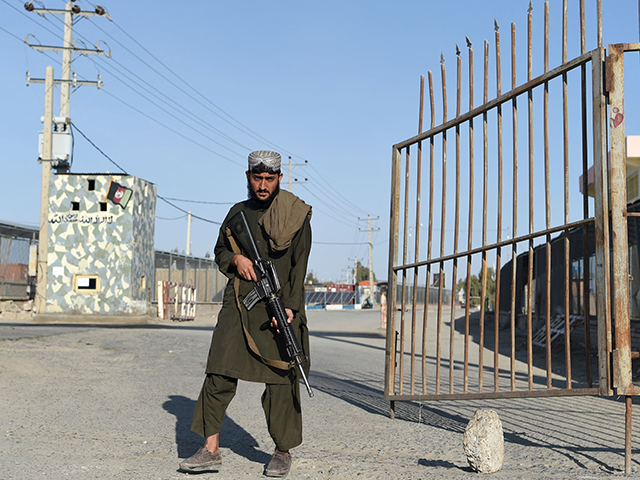An exchange of fire between Taliban terrorists and Iranian border guards on Sunday allegedly caused one death among the Taliban, a southern Afghan police official told Reuters, though Iranian state media reports confirming the border clash made no mention of the alleged casualty.
The disputed border incident occurred on July 31 somewhere between Afghanistan’s southwestern Nimroz province and Iran’s southeastern Sistan and Balochistan province.
“We have one killed and one wounded; the cause of the clash is not clear yet,” Bahram Haqmal, who serves as Nimroz province’s police spokesman, told Reuters on Sunday.
Tehran’s state-run Mehr News Agency confirmed that Iranian border guards engaged in an armed confrontation with Taliban fighters on July 31 but did not report any casualties in connection with the incident. Mehr described the clash as instigated by the Taliban, which allegedly “took […] provocative action and started shooting at the Iranian border guards.”

A Taliban fighter stands guard at the venue for a flag hoisting ceremony of the Taliban flag on the Wazir Akbar Khan hill in Kabul on March 31, 2022. (AHMAD SAHEL ARMAN/AFP via Getty Images)
The Taliban specifically tried to raise their flag “in a region on Iranian soil,” Iran’s state-owned Tasnim news agency reported. This act sparked an argument that prompted the Taliban to open fire not only on Iranian border guards but also on civilian homes nearby.
“The exchange of fire between the two sides flared up for minutes after the Taliban forces fired bullets at the houses on the eastern outskirts of Doost Mohammad [a city in Sistan and Balochistan],” Tasnim revealed.
“[T]he Iranian border guards responded to the shooting from the other side of the border around noon today and after about an hour of limited skirmishes, this issue was ended by the management and domination of the Border Guard of the Islamic Republic of Iran,” Mehr relayed.
Iran’s state-run Fars news agency likewise reported zero deaths as a result of Sunday’s contested border altercation.
“Clashes broke out between the Iranian border guard forces and the Taliban fighters in the village of Shaghalak in Hirmand county in Southeastern Iran,” Meysam Barazandeh, the governor of Sistan and Balouchestan’s Hirmand region, told Fars.
“Our troops showed the necessary response to the border violation by the Taliban, and they responded in return. But there were no casualties,” he stated.
“The fighting is over, and the issue is under investigation,” Barazandeh added.
Sistan and Balochistan is a strategically located province of Iran that borders both Afghanistan and Pakistan. Iranian border guards reportedly regularly encounter challenges to their territory by the Taliban, which seized control of Afghanistan’s seat of government in Kabul in August 2021.
Iran’s deputy interior minister for security affairs, Majid Mirahmadi, told reporters on Sunday evening that Tehran had repeatedly reminded the Taliban to avoid activities that might spark border skirmishes.
“The Afghan border forces must be provided with instructions on the geographical boundaries and the frontline,” he stressed, as quoted by Mehr.
The Tehran Times reported on August 1 that Iran’s special envoy for Afghanistan, Hassan Kazemi Qomi, met with top Taliban members late on July 31 to discuss the border incident earlier that day.
The two sides “agreed to form a joint committee to prevent the recurrence of border clashes,” according to the newspaper.
Tehran reported on June 29 that an Iranian border guard had been killed under unclear circumstances near Milak, which is a designated Iran-Afghan border crossing in Sistan and Balochistan.
Iran shares a 572-mile-long border with Afghanistan. The Taliban captured a strategic Afghan-Iran border crossing called Islam Qala on July 9, 2021. The move was part of a sweeping military offensive that ultimately saw the Sunni Islam-based fundamentalist group gain full control of Afghanistan by the following month. Iran, which is ruled by a Shia Islam-based theocracy, has yet to officially recognize the Taliban as Kabul’s legitimate ruler.
The Taliban had yet to comment at press time on its latest border clash with Iranian border guards on July 31.

COMMENTS
Please let us know if you're having issues with commenting.